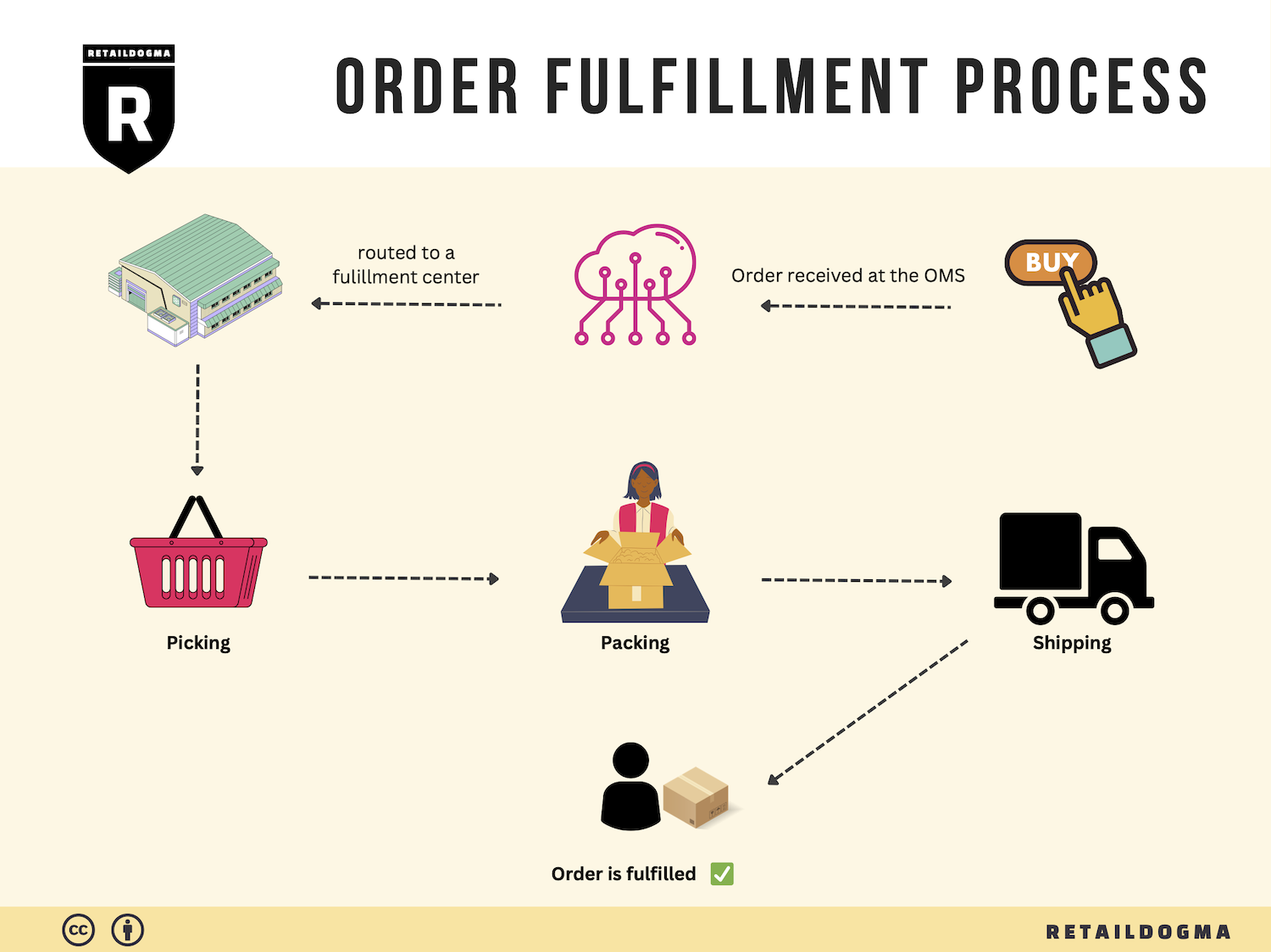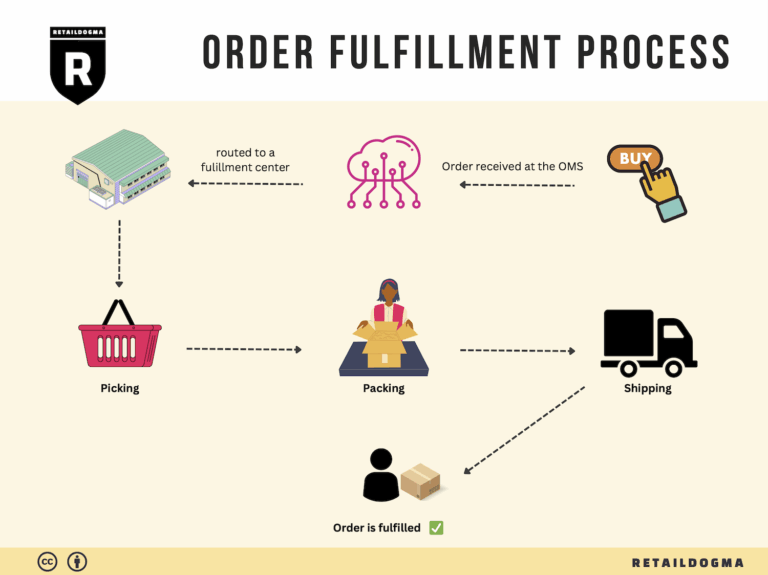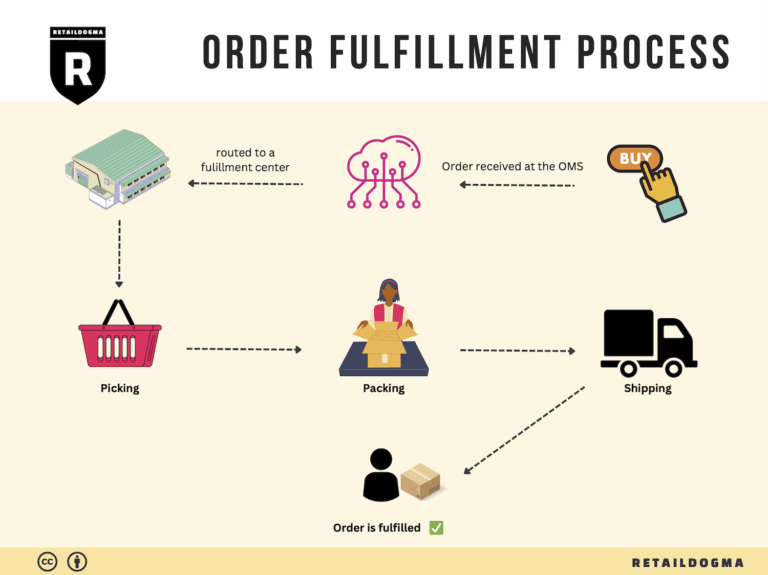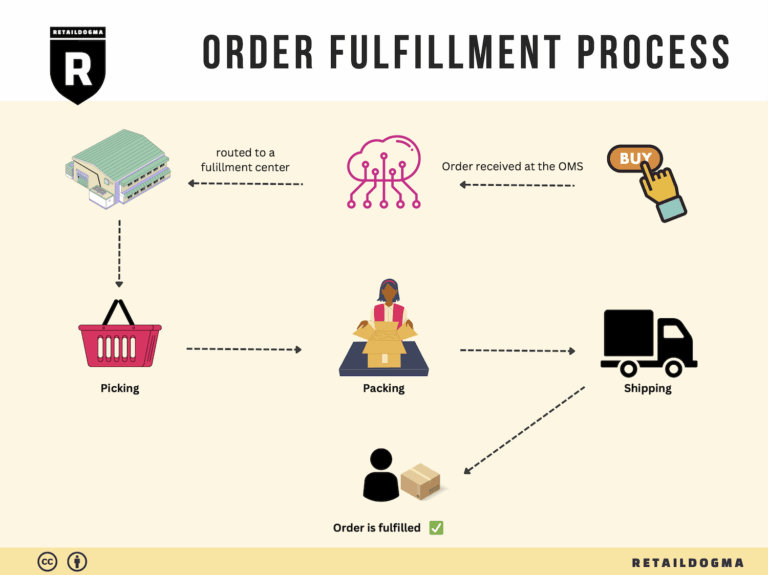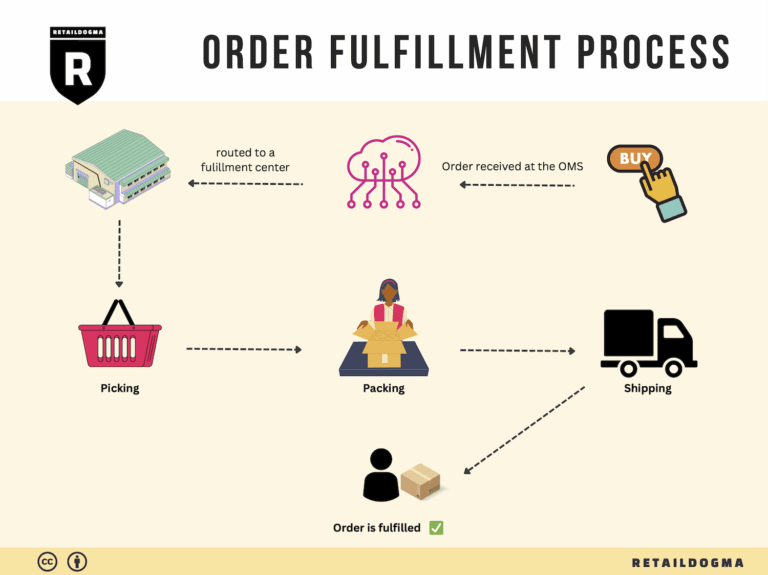How Order Fulfillment Works: A Step-by-Step Guide for Businesses
What is E-commerce Fulfillment? An Introduction for Growing Businesses
The Challenge of Order Fulfillment for Growing E-commerce Businesses
As an e-commerce business owner, you may find yourself at a critical juncture where the excitement of increased sales is overshadowed by the daunting task of packing and shipping orders. The process can quickly become overwhelming, leading to late shipments, misplaced items, and unsatisfied customers. This is a common pain point for growing online businesses. The good news is that you don’t have to navigate this complex landscape alone; understanding e-commerce fulfillment can help streamline your operations and enhance customer satisfaction.
So, what exactly is fulfillment? At its core, e-commerce fulfillment is the process of getting a product from your inventory to your customer’s doorstep. This involves several key steps: receiving inventory, storing products, processing orders, picking items, packing them securely, and finally, shipping them to the customer. Each of these steps requires careful planning and execution to ensure a smooth operation, especially as your business scales.
This guide aims to demystify the various aspects of e-commerce fulfillment, providing you with the knowledge you need to make informed decisions. We will explore different fulfillment models, such as Third-Party Logistics (3PL) and Fulfillment by Amazon (FBA), detailing the pros and cons of each. Additionally, we will cover essential services that fulfillment partners offer, including warehousing, inventory management, and returns processing.
Choosing the right fulfillment partner can significantly impact your business’s efficiency and customer satisfaction. We’ll discuss how to evaluate potential partners based on their capabilities, technology, and customer service. Moreover, we will delve into pricing structures and what factors to consider to ensure you are getting value for your investment.
Ultimately, the goal of this guide is to empower you to make smart logistics decisions that will not only streamline your operations but also enhance your customer experience. By understanding the ins and outs of e-commerce fulfillment, you can focus on what you do best—growing your business. Whether you are considering outsourcing your fulfillment or optimizing your current processes, this guide will serve as a valuable resource on your journey to scaling success.
What You’ll Learn In This Guide
- What is E-commerce Fulfillment? An Introduction for Growing Businesses
- The Order Fulfillment Process: From ‘Buy’ Button to Customer’s Door
- Comparing Fulfillment Models: In-House vs. 3PL vs. Dropshipping
- A Deep Dive into Amazon FBA: Pros, Cons, and Who It’s For
- Core Services Offered by Fulfillment Centers
- How to Choose a Fulfillment Partner: A 6-Point Checklist
- Understanding Fulfillment Pricing: A Breakdown of Common Fees
- Frequently Asked Questions (FAQs) about Fulfillment
- Conclusion: Is Outsourcing Fulfillment the Right Move for Your Business?
- Important Disclaimer
The Order Fulfillment Process: From ‘Buy’ Button to Customer’s Door
1. Receiving Inventory
The first step in the order fulfillment process is receiving inventory. This involves the acceptance of goods from suppliers into the fulfillment center. Once the products arrive, they undergo a thorough inspection to ensure they meet quality standards and match the purchase order. This step is crucial because it sets the foundation for accurate inventory management and helps prevent future discrepancies.
During this stage, items are assigned a unique identifier known as a Stock Keeping Unit (SKU). This key term is essential for tracking inventory levels and movements throughout the fulfillment center. Proper receiving practices not only ensure that the correct items are stocked but also help maintain accurate inventory records, which are vital for efficient order processing later on.
2. Warehouse Storage
After inventory has been received and inspected, the next step is warehouse storage. Products are organized in a systematic manner within the fulfillment center, often categorized by their SKU. Effective storage strategies, such as using shelving systems or pallet racking, facilitate easy access to products and optimize space utilization.
The importance of this step cannot be overstated. Proper organization minimizes the time spent locating items, reduces the risk of errors, and enhances overall operational efficiency. Additionally, maintaining an organized warehouse allows for better visibility of stock levels, which is crucial for managing reorders and ensuring that products are available when needed.
3. Order Picking
Once a customer places an order, the next phase is order picking. This step involves retrieving the selected items from their storage locations based on the order details. Pick lists, which outline the items to be gathered and their respective locations, play a critical role in this process.
Order picking is a pivotal moment in the fulfillment process, as it directly impacts order accuracy and customer satisfaction. Efficient picking methods, such as batch picking or zone picking, can significantly speed up the process. Moreover, using technology like handheld scanners can help confirm that the correct items are being picked, further reducing the chances of errors. The faster and more accurately orders are picked, the quicker they can move to the next step in the fulfillment process.
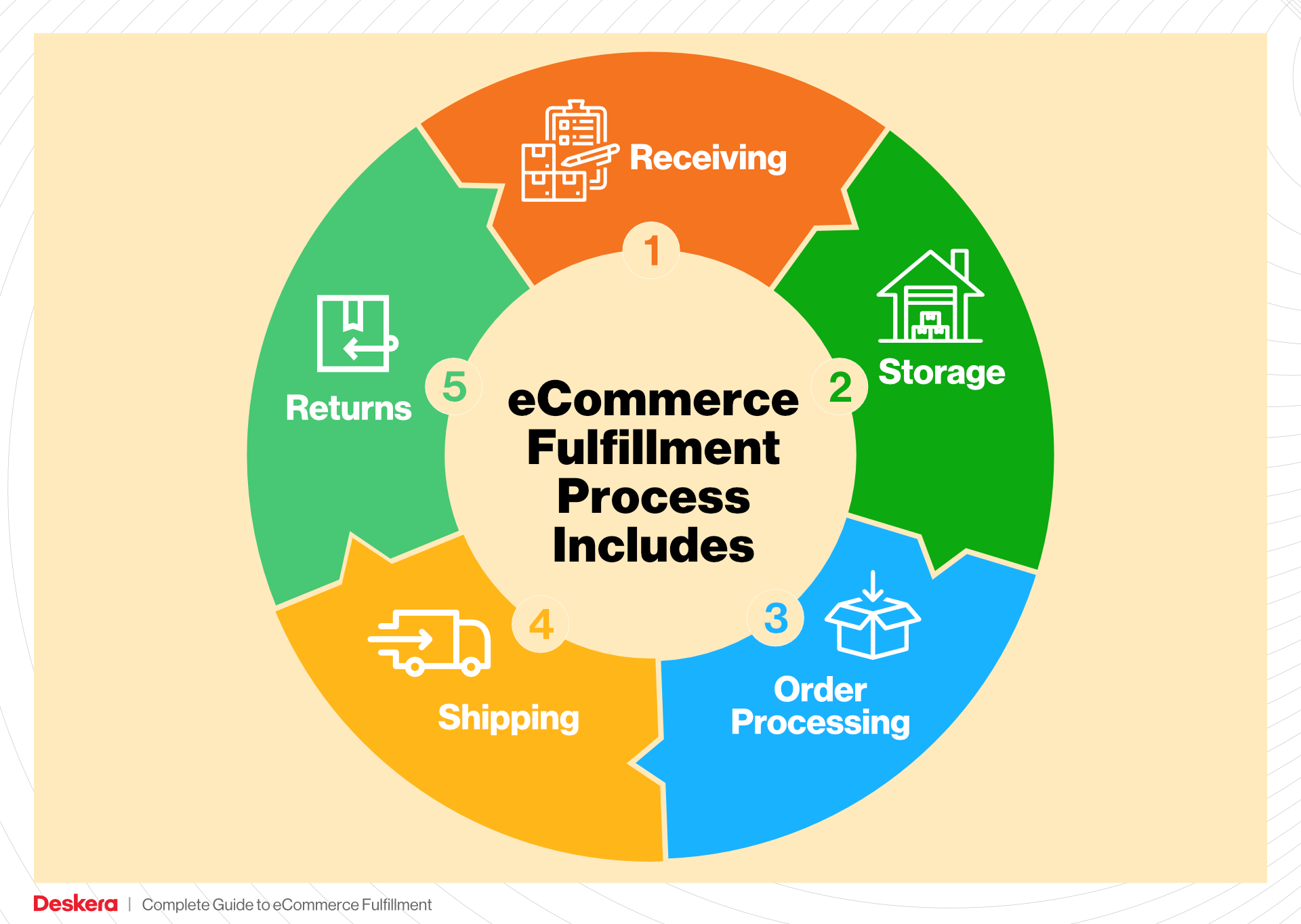
4. Order Packing
After items have been picked, they are transported to the packing area, where the next step occurs: order packing. During this stage, products are carefully packed into boxes or envelopes, ensuring they are protected during transit. The packing process involves using appropriate materials such as bubble wrap, packing peanuts, or void fill to prevent damage.
This step is important for several reasons. First, proper packing ensures that items arrive at the customer’s door in perfect condition, which is critical for maintaining a positive brand reputation. Second, packing efficiency can reduce shipping costs; optimizing box sizes and minimizing wasted space can lead to savings in shipping fees. Additionally, including packing slips and branded materials can enhance the unboxing experience for customers, contributing to brand loyalty.
5. Shipping & Delivery
The final step in the order fulfillment process is shipping and delivery. Once orders are packed, they are labeled and prepared for shipment to the customer. This involves selecting the appropriate shipping carrier and method based on factors such as cost, speed, and destination.
Shipping is a vital component of fulfillment, as it directly affects delivery times and customer satisfaction. Key terms associated with this step include tracking numbers, which allow both the business and the customer to monitor the shipment’s progress. Efficient shipping practices ensure that orders are dispatched promptly, and reliable delivery services can help maintain customer trust.
In conclusion, understanding each step of the order fulfillment process—from receiving inventory to shipping and delivery—is essential for e-commerce businesses looking to scale. By optimizing these stages, companies can enhance operational efficiency, improve customer satisfaction, and ultimately drive growth in their logistics operations.
Comparing Fulfillment Models: In-House vs. 3PL vs. Dropshipping
Fulfillment Model Comparison
| Model | Who Handles Inventory | Best For (Business Stage) | Key Advantage | Key Disadvantage |
|---|---|---|---|---|
| In-House Fulfillment | The business itself | Startups, Established | Full control over inventory and processes | High upfront costs and resource requirements |
| Third-Party Logistics (3PL) | A third-party provider | Growing, Scaling | Scalability and reduced operational burden | Less control over inventory and fulfillment speed |
| Dropshipping | Supplier or manufacturer | Startups, Small Businesses | Low startup costs and no inventory risk | Lower profit margins and potential quality issues |
In-House Fulfillment
In-house fulfillment is a model where businesses manage their own inventory and fulfillment operations. This approach allows for complete control over the entire process, from storage to order processing and shipping. Companies that opt for in-house fulfillment often invest in their own warehouse space, hire staff, and implement systems to handle logistics. This model is particularly advantageous for businesses that require a high level of customization in their order fulfillment, such as those with unique packaging requirements or specialized products. However, it also comes with significant challenges. The initial setup costs can be substantial, including rent for warehouse space, purchasing equipment, and hiring personnel. Additionally, managing an in-house fulfillment operation requires ongoing investments in technology and human resources to ensure efficiency and accuracy. As businesses grow, scaling up operations can become complex and resource-intensive.
Third-Party Logistics (3PL)
Third-party logistics (3PL) providers, like Sisk Fulfillment Services, offer outsourced fulfillment solutions that manage inventory, warehousing, and shipping on behalf of businesses. This model is ideal for growing companies looking to scale without the burden of managing logistics internally. By partnering with a 3PL, businesses can leverage the provider’s expertise, technology, and infrastructure to improve operational efficiency. Key advantages of using a 3PL include reduced overhead costs, the ability to focus on core business activities, and the flexibility to scale operations up or down based on demand. However, while 3PLs can streamline processes, businesses may face challenges with inventory control and fulfillment speed, as they rely on an external partner. Effective communication and coordination are essential to ensure that service level agreements are met and that customer expectations are consistently exceeded.
Dropshipping
Dropshipping is a fulfillment model where retailers do not keep products in stock. Instead, when a customer makes a purchase, the retailer forwards the order to a supplier who then ships the product directly to the customer. This model has gained popularity, especially among startups and small businesses, due to its low startup costs and minimal financial risk. Since there is no need to invest in inventory upfront, businesses can test new products without significant financial commitments. However, dropshipping comes with its own set of challenges. Profit margins can be lower compared to traditional retail models since suppliers often charge higher prices for handling fulfillment. Additionally, retailers have less control over product quality, shipping times, and inventory levels, which can lead to potential customer dissatisfaction. Establishing strong relationships with reliable suppliers is crucial for maintaining quality and ensuring a seamless customer experience in a dropshipping model.
Conclusion
When choosing a fulfillment model, e-commerce business owners must consider their current business stage, operational capabilities, and long-term goals. In-house fulfillment offers control but requires significant resources, while 3PL provides scalability and expertise at the cost of some control. Dropshipping offers low entry barriers but can lead to lower profit margins and quality concerns. Each model has its unique advantages and challenges, and the right choice will depend on the specific needs and circumstances of the business. As companies grow and evolve, they may even find that a hybrid approach, combining elements of these models, provides the most effective solution for their fulfillment needs.
A Deep Dive into Amazon FBA: Pros, Cons, and Who It’s For
Understanding Fulfillment by Amazon (FBA)
Fulfillment by Amazon (FBA) is a service that allows e-commerce sellers to store their products in Amazon’s fulfillment centers. Amazon takes care of storage, packaging, and shipping, while also managing customer service and returns. This service leverages Amazon’s extensive logistics network, enabling sellers to reach millions of customers quickly and efficiently.
How FBA Works
- Product Listing: Sellers create product listings on Amazon and select FBA as their fulfillment method.
- Inventory Shipment: Sellers send their products to Amazon’s fulfillment centers. Amazon provides guidelines on how to prepare and label products for shipment.
- Storage: Once received, products are stored in Amazon’s warehouses until sold.
- Order Processing: When a customer orders a product, Amazon picks, packs, and ships the item on behalf of the seller.
- Customer Service: Amazon handles all customer inquiries and returns, providing a seamless experience for both sellers and buyers.
- Payment: After the sale, Amazon deducts fees for storage and fulfillment, then transfers the remaining funds to the seller.
Pros of Using FBA
1. Prime Eligibility
FBA products are automatically eligible for Amazon Prime, which attracts millions of customers who prefer fast shipping options. This can significantly increase sales, as Prime members often filter their searches to only show Prime-eligible items.
2. Customer Trust
Amazon is synonymous with trust and reliability in e-commerce. By using FBA, sellers benefit from Amazon’s reputation, which can lead to increased customer confidence and higher conversion rates. Customers are more likely to purchase from sellers who utilize FBA due to the assurance of quick shipping and hassle-free returns.
3. Multi-Channel Fulfillment
FBA allows sellers to fulfill orders from multiple sales channels, not just Amazon. This means that if a seller sells on their own website or other platforms, they can still use Amazon’s fulfillment services to manage inventory and shipping, streamlining operations.
4. Simplified Logistics
Sellers do not have to worry about the complexities of storage, packaging, and shipping logistics. This allows them to focus on other aspects of their business, such as marketing and product development.

5. Scalability
FBA is designed to help businesses scale efficiently. As sales increase, sellers can easily send more inventory to Amazon without needing to invest in additional warehousing or logistics infrastructure.
Cons of Using FBA
1. High Fees
FBA is not without its costs. Sellers incur various fees, including storage fees for inventory held in Amazon’s warehouses and fulfillment fees based on product size and weight. These fees can add up quickly, particularly for sellers with lower-margin products.
2. Strict Inventory Rules
Amazon has stringent inventory management rules, including limits on the amount of inventory that can be sent to their warehouses. Sellers must also adhere to specific labeling and packaging requirements, which can add complexity to the fulfillment process.
3. Commingling Risks
FBA products may be commingled with inventory from other sellers, meaning that a seller’s product could be shipped from another seller’s stock. This poses risks, such as receiving damaged or counterfeit products, which can harm a seller’s reputation and customer satisfaction.
4. Loss of Control
When using FBA, sellers relinquish control over the fulfillment process. Issues such as shipping delays or inventory mismanagement are handled by Amazon, which can be frustrating for sellers who prefer a hands-on approach.
5. Difficulty in Managing Returns
While Amazon handles returns, sellers may find it challenging to track and manage returned items. This can complicate inventory management and lead to discrepancies in stock levels.

Who is FBA Best For?
Fulfillment by Amazon is particularly well-suited for:
- Small to Medium-Sized Businesses: Sellers looking to scale quickly without the overhead of managing logistics can benefit from FBA’s infrastructure.
- New Sellers: Entrepreneurs entering the e-commerce space can leverage Amazon’s vast customer base and trusted fulfillment services to gain traction.
- Sellers of Fast-Moving Consumer Goods: Products with a high turnover rate can benefit from FBA’s quick shipping and storage capabilities, maximizing sales potential.
- Businesses with Limited Logistics Experience: Companies lacking experience in warehousing and distribution can find FBA’s managed services beneficial for streamlining operations.
In conclusion, while FBA offers numerous advantages, including access to a vast customer base and simplified logistics, it also presents challenges such as high fees and strict inventory rules. Business owners should carefully evaluate their specific needs, products, and operational capabilities to determine if FBA is the right fit for their e-commerce strategy.
Core Services Offered by Fulfillment Centers
Inventory Management & Warehousing
Effective inventory management and warehousing are the backbone of successful e-commerce operations. Fulfillment centers like Sisk Fulfillment Services provide businesses with advanced inventory management systems that ensure products are stored securely and efficiently. This service encompasses the tracking of stock levels, order statuses, and reordering processes, often facilitated through sophisticated software that integrates with your e-commerce platform.
The benefits of robust inventory management are manifold. First, it minimizes the risk of stockouts and overstock situations, helping businesses maintain optimal inventory levels. This is crucial for meeting customer demand without incurring excess holding costs. Additionally, a well-organized warehouse allows for faster order processing and fulfillment, significantly reducing lead times. This efficiency not only enhances customer satisfaction but also improves overall operational productivity. By leveraging the warehousing capabilities of a fulfillment center, e-commerce businesses can scale effectively, responding quickly to market fluctuations and customer needs.
Pick and Pack Services
Pick and pack services are essential for e-commerce businesses that require efficient order fulfillment. This process involves selecting products from the warehouse (picking) and packaging them for shipment (packing). Fulfillment centers employ specialized staff trained in fast and accurate picking techniques, often using technology such as barcodes and handheld scanners to ensure precision.
The primary advantage of pick and pack services lies in their ability to handle varying order sizes and complexities. Whether fulfilling single-item orders or bulk shipments, fulfillment centers can adapt to your specific needs. This flexibility is particularly beneficial for businesses experiencing seasonal spikes in demand or those that operate with a diverse product catalog. Additionally, quick turnaround times on order fulfillment lead to improved customer experiences, fostering loyalty and repeat business. By outsourcing pick and pack services, e-commerce businesses can focus on growth strategies rather than the logistical challenges of order fulfillment.
Kitting and Assembly
Kitting and assembly services involve the creation of product bundles or kits, combining multiple items into a single package for easier distribution and sale. This service is particularly useful for businesses that offer promotional items, subscription boxes, or any products requiring assembly before shipping. Fulfillment centers like Sisk excel in this area, managing everything from simple kit assembly to complex custom packaging.
The benefits of kitting and assembly extend beyond mere convenience. By offering bundled products, businesses can enhance perceived value, encourage higher average order values, and streamline inventory management. Kitting also allows for creative marketing opportunities, as unique bundles can attract new customers or incentivize existing ones. Moreover, professional assembly ensures that products are packaged attractively and correctly, enhancing the overall customer experience. When e-commerce businesses utilize kitting and assembly services, they can create tailored offerings that resonate with their target audience while saving time and resources.
Returns Management (Reverse Logistics)
Returns management, often referred to as reverse logistics, is a critical component of e-commerce fulfillment that addresses the complexities associated with product returns. A well-structured returns management process is essential for maintaining customer satisfaction and loyalty. Fulfillment centers streamline this process by handling returns efficiently, from receiving returned items to restocking or processing them according to the business’s policies.
The importance of effective returns management cannot be overstated. A smooth returns process instills confidence in customers, as they know they can return products easily if they are unsatisfied. This can lead to increased sales, as customers are more likely to purchase from a business that offers hassle-free returns. Furthermore, fulfillment centers can analyze return data to identify patterns, helping businesses improve product offerings and reduce future returns. By outsourcing returns management to a fulfillment center, e-commerce businesses can enhance their overall efficiency and customer service, allowing them to focus on growth and innovation rather than the complexities of reverse logistics.
In conclusion, partnering with a fulfillment center offers e-commerce businesses a range of core services that can significantly enhance operational efficiency and customer satisfaction. From inventory management and pick and pack services to kitting and assembly, as well as returns management, these services provide the necessary support for businesses to scale effectively and thrive in a competitive marketplace.
How to Choose a Fulfillment Partner: A 6-Point Checklist
Location & Warehouse Network
Importance: The geographical location of a fulfillment partner can significantly impact shipping times, costs, and overall customer satisfaction. A partner with a well-distributed warehouse network can facilitate faster delivery to various regions, reducing shipping expenses and improving service levels.
Questions to Ask:
1. Where are your warehouses located, and how many do you operate?
2. Can you fulfill orders from multiple locations to optimize shipping times?
3. How do you handle regional shipping costs and logistics?
Technology & Integrations
Importance: In today’s e-commerce landscape, technology plays a pivotal role in efficient order fulfillment. A partner with robust technology and seamless integrations can streamline operations, improve accuracy, and provide real-time visibility into inventory and order status.
Questions to Ask:
1. What fulfillment management software do you use, and how does it integrate with my existing e-commerce platform (e.g., Shopify, WooCommerce)?
2. Do you offer real-time inventory tracking, and how can I access this data?
3. What reporting capabilities do you provide to help me analyze fulfillment performance?
Specializations (e.g., cold storage, oversized items)
Importance: Depending on your product types, you may require specific handling capabilities. Whether you deal with temperature-sensitive goods or oversized items, it’s crucial to partner with a fulfillment provider that has the necessary expertise and facilities.
Questions to Ask:
1. What specific services do you offer for specialized products (e.g., cold storage, hazardous materials)?
2. Can you accommodate custom packaging or kitting requirements?
3. What certifications or compliance measures do you have in place for handling specialized items?
Scalability & Capacity
Importance: As your business grows, your fulfillment needs will likely change. A partner should be able to scale operations to meet increased demand without sacrificing quality or service. This flexibility is vital for managing seasonal spikes or sudden growth.
Questions to Ask:
1. How do you handle fluctuations in order volume, especially during peak seasons?
2. What is your current capacity, and how quickly can you scale up operations if needed?
3. Have you successfully managed scalability for other clients in similar industries?
Pricing and Contracts
Importance: Understanding the pricing structure and contractual obligations is essential for budgeting and financial planning. Transparent pricing helps avoid hidden fees and ensures you receive value for your investment.
Questions to Ask:
1. Can you provide a detailed breakdown of your pricing structure (e.g., storage fees, pick-and-pack fees, shipping costs)?
2. Are there any hidden fees I should be aware of?
3. What are the terms of the contract, and what is your policy on contract termination or renewal?
Customer Support & Reviews
Importance: Exceptional customer support can be a game-changer in your fulfillment operations. A responsive partner can quickly resolve issues, adapt to changes, and provide insights that enhance your overall fulfillment strategy. Additionally, reviews and testimonials can provide insight into their reliability and service quality.
Questions to Ask:
1. What level of customer support can I expect? Will I have a dedicated account manager?
2. How do you handle order discrepancies or fulfillment errors?
3. Can you provide references or case studies from other clients, particularly those in my industry?
Conclusion
Choosing the right fulfillment partner is a critical decision that can significantly impact your e-commerce business’s efficiency and customer satisfaction. By following this checklist and asking the right questions, you can make a more informed choice that aligns with your business goals. Remember that a successful partnership is built on mutual understanding, trust, and a shared commitment to excellence in service.
Understanding Fulfillment Pricing: A Breakdown of Common Fees
Initial Setup Fees
Initial setup fees are one-time charges that cover the costs associated with establishing your account with a fulfillment service provider. These fees may include costs for account configuration, integration with your e-commerce platform, and any necessary software or system setup. At Sisk Fulfillment Services, for example, this may involve customizing their fulfillment system to align with your business needs, ensuring that inventory management and order processing are seamlessly integrated.
The calculation of initial setup fees can vary widely based on the complexity of your needs. Simple accounts with straightforward requirements may incur lower fees, while businesses needing advanced customization or integration with multiple sales channels might face higher costs. It’s essential to discuss your specific requirements upfront to get a clear estimate.
Receiving Fees
Receiving fees are charged for the process of accepting and processing incoming inventory. This includes unloading products from trucks, checking them for quality and quantity, and entering them into the warehouse management system. The fee is typically calculated on a per-pallet or per-box basis, depending on the fulfillment provider’s pricing structure.
At Sisk, receiving fees may be influenced by factors such as the volume of inventory being received and the complexity of the receiving process. For instance, products that require special handling or inspection may incur additional costs. To avoid unexpected charges, it is advisable to clarify the receiving process with your fulfillment partner and understand how fees are structured based on your specific inventory needs.
Storage Fees (per pallet/bin)
Storage fees are charged for the space your products occupy in the fulfillment center. These fees can be calculated on a per-pallet or per-bin basis, depending on how your inventory is stored. For example, if you have bulky items requiring more space, the cost may be higher compared to smaller items that can be stored more efficiently.
Sisk Fulfillment Services typically assesses storage fees based on the total volume of products stored and the duration of storage. It’s important to monitor your inventory turnover and consider strategies to minimize storage costs, such as optimizing your order quantities and frequency. Additionally, inquire about any seasonal variations in storage fees, as some providers may charge differently during peak seasons.
Pick & Pack Fees (per item/order)
Pick & pack fees are incurred for the process of selecting items from inventory and preparing them for shipment. This fee can vary based on the number of items in an order and the complexity of the packing process. For instance, a straightforward order containing a single item will generally have a lower pick & pack fee than an order with multiple items requiring special packaging.
At Sisk, the pick & pack fee may be calculated per item or per order, and it may include additional charges for special packaging or kitting services. Understanding the pick & pack fee structure is crucial for budgeting, especially if your business model involves frequent small orders or complex kitting. Communicate your order patterns to your fulfillment provider to ensure you receive an accurate estimate of these fees.
Shipping Fees
Shipping fees represent the costs associated with delivering your products to customers. These fees can vary significantly based on factors such as package weight, dimensions, shipping distance, and the chosen shipping method (e.g., standard, expedited). Fulfillment providers like Sisk often leverage relationships with multiple carriers to offer competitive shipping rates, which can help reduce overall costs.
Shipping fees can also include additional services, such as tracking, insurance, and handling fees for special delivery requirements. It’s essential to evaluate your shipping options and discuss potential strategies for cost savings, such as bulk shipping discounts or regional distribution centers that can shorten delivery times and reduce costs.
Tips for Getting an Accurate Quote
-
Be Transparent: Provide detailed information about your business needs, including order volume, product types, and fulfillment complexity. The more information you share, the more accurate the quote will be.
-
Request Itemized Quotes: Ask for a breakdown of all potential fees, including setup, receiving, storage, pick & pack, and shipping. This will help you understand the total cost and identify areas where you might save.
-
Inquire About Discounts: Some fulfillment providers offer discounts for higher volumes or long-term contracts. Discuss your expected growth and order patterns to see if you qualify for any cost reductions.
-
Understand Fee Structures: Familiarize yourself with how each fee is calculated and any variables that may affect costs. This knowledge will help you plan your budget and manage your operational expenses effectively.
-
Review Contracts Carefully: Before signing, carefully review the contract terms, including any clauses related to fee changes, minimum service levels, and performance metrics. This can prevent unexpected costs in the future.
By following these tips and understanding the various fees associated with fulfillment services, you can make informed decisions that align with your business goals and help you scale efficiently.
Frequently Asked Questions (FAQs) about Fulfillment
1. What is Sisk Fulfillment Service?
Sisk Fulfillment Service is a comprehensive logistics provider specializing in order fulfillment for e-commerce, membership organizations, dietary supplements, and subscription services. Established in 1983, Sisk combines personalized customer service with automated processes to efficiently handle both small and large volumes of orders.
2. How does Sisk ensure order accuracy?
Sisk employs a multi-step verification process to ensure order accuracy. Each order is picked, packed, and shipped by specialized teams using barcodes and handheld scanners. Additionally, a manual “3-step check” system is in place to verify that the correct items are included in each shipment, reducing the likelihood of errors.
3. What types of fulfillment services does Sisk offer?
Sisk provides a variety of fulfillment services, including:
– Dietary supplement fulfillment
– Membership and donor fulfillment
– Subscription premium fulfillment
– Custom kit assembly
– Personalized acknowledgment fulfillment
– eCommerce pick-and-pack fulfillment
Each service is tailored to meet the specific needs of clients across various industries.
4. What is the difference between a warehouse and a fulfillment center?
A warehouse primarily serves as a storage space for goods, focusing on inventory management. In contrast, a fulfillment center goes beyond storage by handling the entire process of order fulfillment, including picking, packing, shipping, and often customer service. Fulfillment centers are designed for efficiency and speed, catering specifically to e-commerce and direct-to-consumer businesses.
5. What is a 3PL?
A Third-Party Logistics (3PL) provider is a company that offers outsourced logistics services, including warehousing, fulfillment, and distribution. Sisk Fulfillment Service operates as a 3PL, allowing businesses to outsource their logistics needs, which can lead to cost savings, improved efficiency, and the ability to focus on core business activities.
6. How much do fulfillment services cost?
The cost of fulfillment services varies based on several factors, including order volume, storage needs, packaging requirements, and shipping destinations. Typically, fulfillment costs include warehousing fees, picking and packing fees, and shipping charges. For a precise quote, businesses should consult directly with Sisk Fulfillment Service to discuss their specific needs and volume.
7. How does Sisk handle returns management?
Sisk offers a comprehensive returns management service that streamlines the process for both businesses and customers. This includes receiving returned items, inspecting their condition, restocking them if applicable, and updating inventory levels. Efficient returns management can improve customer satisfaction and loyalty.
8. Can Sisk accommodate seasonal fluctuations in order volume?
Yes, Sisk is equipped to handle seasonal fluctuations in order volume. With a scalable infrastructure and a team of experienced professionals, Sisk can ramp up operations to meet increased demand during peak seasons and scale back during slower periods, ensuring that clients’ fulfillment needs are consistently met.
9. How does Sisk ensure compliance with regulations for dietary supplements?
Sisk operates in compliance with FDA regulations and is NSF cGMP certified for dietary supplement fulfillment. This includes maintaining proper temperature and humidity controls, managing lot numbers and expiration dates, and implementing quality control measures throughout the fulfillment process to ensure product safety and compliance.
10. What is the onboarding process for new clients at Sisk?
The onboarding process at Sisk Fulfillment Service involves several steps to ensure a smooth transition. Initially, Sisk will conduct a needs assessment to understand the client’s specific requirements. This is followed by setting up inventory management systems, integrating with existing e-commerce platforms, and training the client’s staff on how to use the system. Throughout this process, Sisk emphasizes open communication to address any concerns and ensure all parties are aligned.
Conclusion: Is Outsourcing Fulfillment the Right Move for Your Business?
Evaluating the Benefits of Outsourcing Fulfillment
Outsourcing fulfillment can be a game-changer for e-commerce businesses aiming to scale efficiently. One of the primary advantages is the significant time savings it offers. By delegating order processing, packing, and shipping to a specialized fulfillment service like Sisk, you can redirect your focus toward core business activities such as marketing, product development, and customer engagement. This shift not only enhances productivity but also allows you to concentrate on strategic growth initiatives.
Scalability is another critical benefit of partnering with a fulfillment service. As your business grows, so does the complexity of managing logistics. A proficient fulfillment partner provides the infrastructure and resources necessary to handle increased order volumes without compromising quality or customer service. This flexibility enables you to adapt to market demands swiftly, ensuring you can meet customer expectations during peak periods, such as holiday seasons or promotional events.
Moreover, the expertise offered by established fulfillment services can be invaluable. Companies like Sisk bring years of experience and industry knowledge, which translates into improved efficiency and accuracy in order fulfillment. Their familiarity with regulatory requirements, quality control processes, and technology integration ensures that your operations are not only compliant but also optimized for performance.
However, the success of outsourcing fulfillment hinges on selecting the right partner. It’s crucial to evaluate potential providers based on their capabilities, customer service, and alignment with your business goals.
Take Action
To determine if outsourcing fulfillment is the right move for your business, conduct a thorough audit of your current shipping and logistics processes. Identify pain points, inefficiencies, and opportunities for improvement. This assessment will provide clarity on whether a fulfillment partner can help you scale effectively and enhance your overall operational efficiency. Don’t hesitate to explore your options; the right partnership could be the key to unlocking your business’s full potential.
Important Disclaimer
⚠️ Important Disclaimer
The information in this guide is for educational purposes. Fulfillment services, pricing, and platform features change frequently. Always conduct your own due diligence and consult with providers directly before making business decisions.
